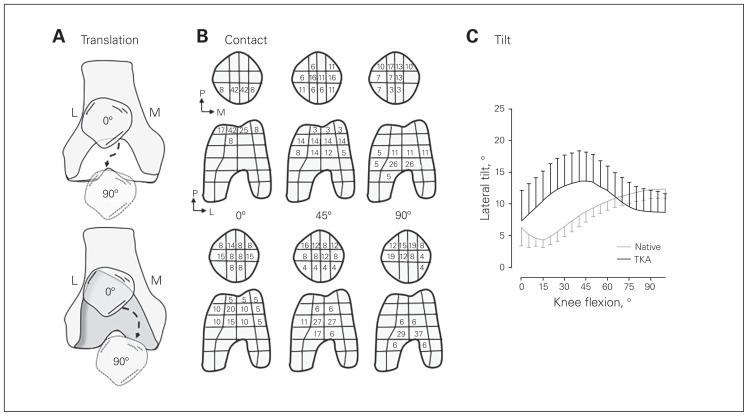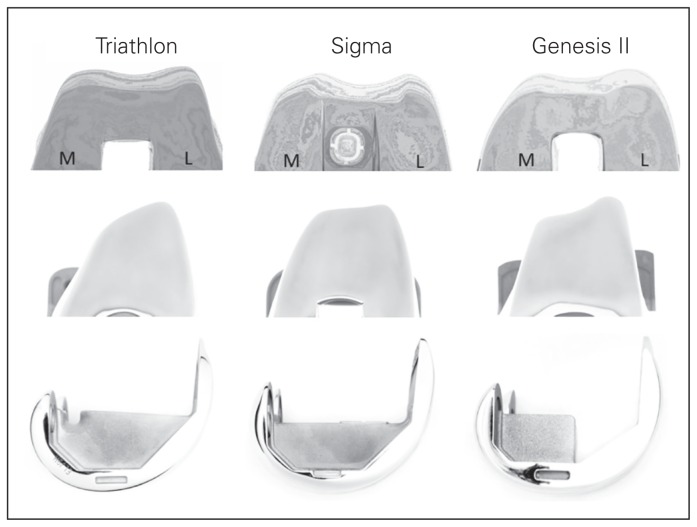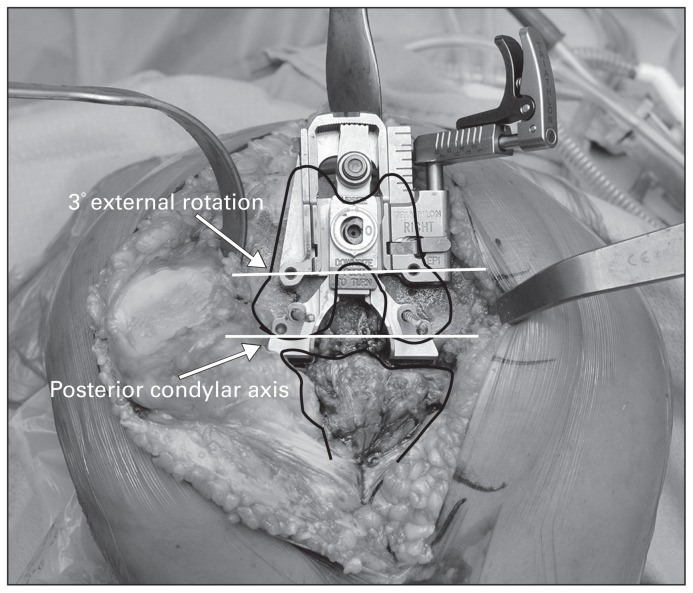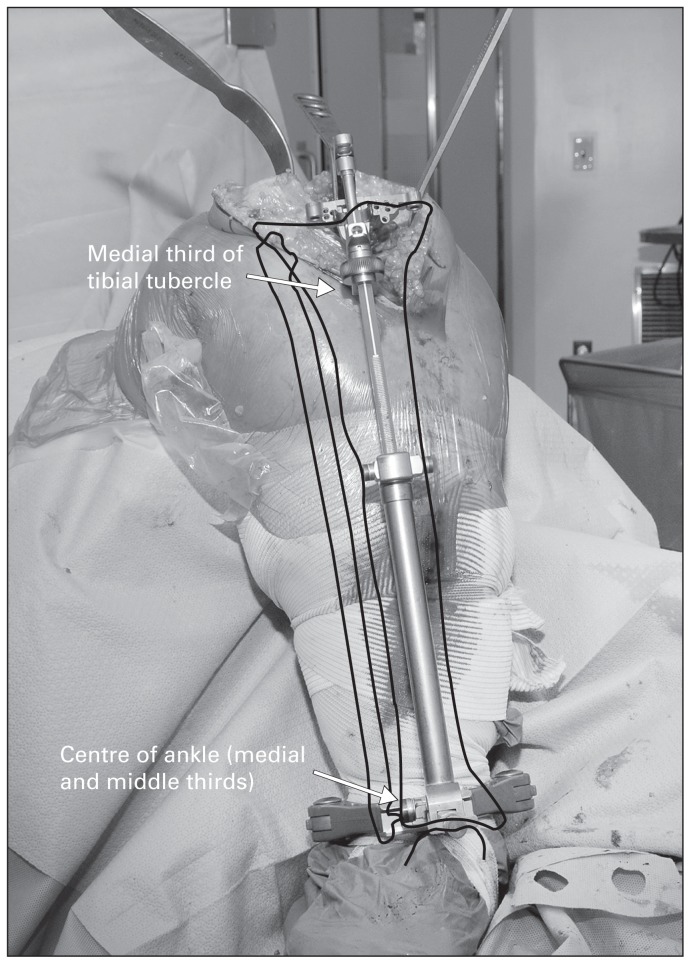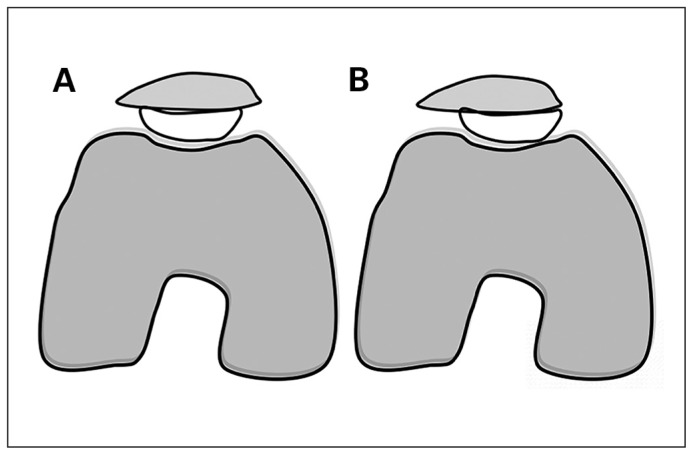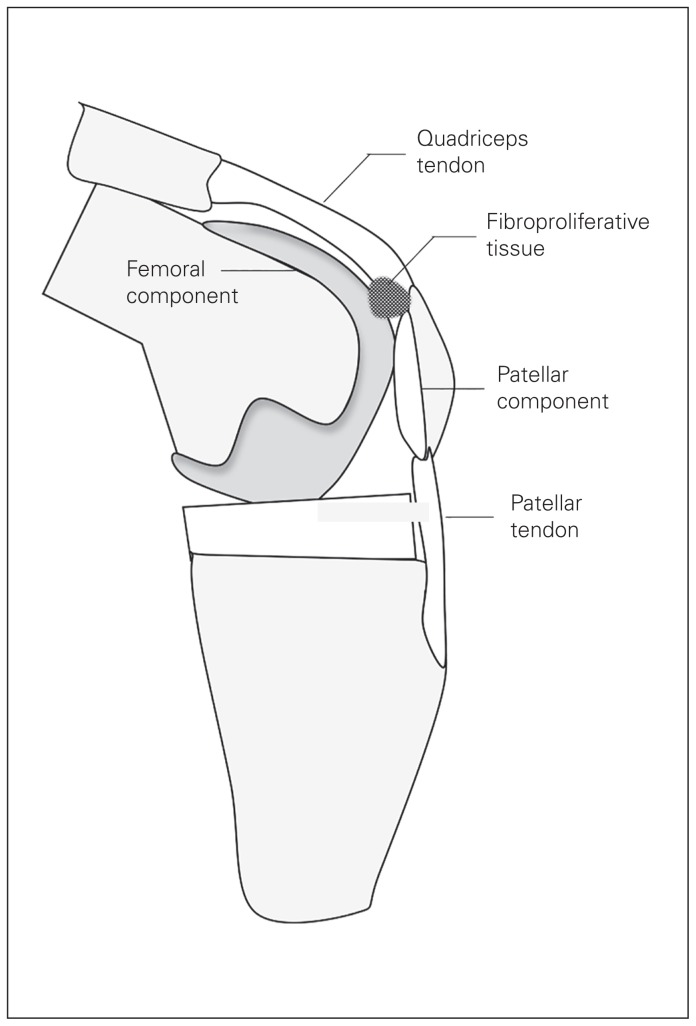Abstract
Total knee arthroplasty (TKA) is one of the most successful procedures in orthopedic surgery. Nevertheless, postoperative patellofemoral complications remain a challenging problem, affecting a substantial proportion of patients. Complications involving the patellofemoral joint (PFJ) can occur in both resurfaced and nonresurfaced patellae. Types of PFJ complications include anterior knee pain, maltracking, fracture, avascular necrosis and patellar clunk. The causes of patellofemoral complications can be categorized into patient-, surgeon- and implant-related factors. Patient characteristics such as female sex, young age, depression and increased body mass index have been linked with increased complications. Important technical considerations to avoid complications include achieving appropriate rotational alignment of the femoral and tibial components, maintaining joint line height, medializing the patellar button and avoiding “overstuffing” the PFJ. Component design features such as conformity, shape and depth of the femoral trochlea have also been shown to be important. Although the cause of patellofemoral complications after TKA may sometimes be unknown, it remains important to minimize errors that can lead to these complications.
Abstract
La prothèse totale du genou (PTG) est l’une des interventions qui réussit le mieux en chirurgie orthopédique. Les complications fémoro-patellaires postopératoires n’en restent pas moins un problème complexe qui affecte une proportion substantielle de patients. Les complications affectant l’articulation fémoro-patellaire (AFP) peuvent survenir en présence de rotules resurfacées ou non. Les types de complications de l’AFP incluent, douleur au devant du genou, défaut d’alignement, fracture, nécrose avasculaire et accrochage rotulien. Les causes des complications fémoro-patellaires peuvent appartenir à diverses catégories selon qu’elles sont liées au patient, au chirurgien ou à la prothèse elle-même. Des caractéristiques liées aux patients, comme le fait d’être de sexe féminin, le jeune âge, la dépression et un indice de masse corporelle élevé, sont associées à une hausse des complications. Les enjeux techniques importants pour éviter les complications incluent : obtenir un alignement rotationnel approprié des éléments fémoraux et tibiaux, maintenir la hauteur de la ligne articulaire, médialiser le bouton patellaire et éviter d’encombrer l’AFP. Les caractéristiques de la modélisation des éléments, comme la conformité, la forme et la profondeur de la trochlée fémorale se sont aussi révélées importantes. Même si la cause des complications fémoro-patellaires post-PTG est parfois inconnue, il est important de prévenir les erreurs susceptibles de mener à de telles complications.
Patellofemoral complications historically have contributed up to 50% of revision surgery.1 With modern design refinements and improved techniques, the burden of revision from patellofemoral complications is less than it was previously; however, these complications remain some of the most challenging problems in knee arthroplasty.
Complications involving the patellofemoral joint (PFJ) can occur with both resurfaced and nonresurfaced patellae. In resurfaced patellae, complications include patellar maltracking, fracture, avascular necrosis, clunk and anterior knee pain. In knees with nonresurfaced patellae, some of the same complications can take place, such as maltracking, clunk, avascular necrosis and anterior knee pain, in addition to a possibly higher rate of reoperation.
In this evidence-based review, we discuss basic anatomic and kinematic features of the PFJ and review the types, mechanisms and causes of patellofemoral complications in total knee arthroplasty (TKA). The role of patient factors, implant design features and surgical techniques are reviewed.
Biomechanics of patellofemoral joint
The most important function of the patellofemoral articulation is to increase the efficacy of the quadriceps muscle, facilitating knee extension. Studies have shown that the patella increases the extension force by as much as 50%.2 As a result, the PFJ experiences substantial forces. In the native knee, biomechanical modelling has shown that PFJ reactive forces during activities of daily living can range from 2.5 to 7.6 times the body weight.3 Aside from increasing quadriceps torque, the patella serves to increase the surface area of force distribution and aids in centralizing the extensor mechanism forces.2
Although there are similarities in patellofemoral kinematics between native and prosthetic knees, differences exist with respect to the patellar translation, areas and magnitude of contact forces, and patellar tilt (Fig. 1). The native patella exhibits medial translation in early flexion, followed by progressively increased lateral translation with increased flexion.4 Similar to the native patella, the prosthetic patella experiences most of the contact distally in low amounts of flexion. The point of contact migrates more proximally with increasing flexion, reaching the superior pole in 60°–90° of flexion.5 Although the cause is likely multifactorial, it may be partially explained by reduced, or occasionally reversed, femoral rollback following TKA.6 Patellar tilt appears to increase with increasing flexion in both native and prosthetic knees; however, the increase appears to be more substantial after TKA.4 Finally, prosthetic knees lose the normal 5° external rotation of the tibia on the femur (“screw-home mechanism”).4
Fig. 1.
Summary of native (top row) and prosthetic (bottom row) patellofemoral kinematics. (A) Patellar tracking between 0° and 90°. The native patella translates medially in early flexion and translates laterally in further flexion. The patella tracks more medially following total knee arthroplasty (TKA). (B) Frequency-of-contact map showing patellofemoral contact between 0° and 90°. The distal patella initiates contact and, with increasing flexion, the contact area migrates more proximally (adapted and redrawn from reference 5 with permission of Elsevier). (C) Patellar tilt before and after TKA. The patellar tilt appears to be increased following TKA, particularly between 10° and 45° (reproduced from reference 4 with permission of Springer). L = lateral; M = medial; P = proximal.
Implant features
Femoral component
The morphological features of femoral and patellar components have substantial effects on patellofemoral kinematics. Among the various features of the femoral component, the anatomic features that affect patellofemoral kinematics design include the asymmetry of the trochlea, the depth of the trochlear groove and the proximal extension of the trochlea (Fig. 2).7–9
Fig. 2.
Anteroposterior, axial and sagittal photographs of Triathlon (Stryker), Sigma (DePuy Synthes) and Genesis II (Smith & Nephew) femoral components. Modern components share common features, such as proximal extension of the trochlea, raised lateral trochlear flange, lateralized groove and deepened trochlea. L = lateral; M = medial.
Extending the trochlea proximally allows the patella to enter the trochlear groove properly. In femoral components where the trochlear surface is terminated at the proximal extent of the femoral cartilage, the patella is not engaged in prosthesis in full extension, leaving room for tracking abnormalities as the patella enters the trochlear groove.7 In an early cadaveric study, Yoshii and colleagues8 performed an in vitro comparison of various trochlear designs and found that a deepened trochlear groove and a raised lateral flange allowed the patellar button to be constrained in the groove and minimized tracking abnormalities. Similar findings were reported by Petersilge and colleagues10 in a cadaveric study and by Theiss and colleagues9 in a retrospective clinical study. Although design elements are important for facilitating tracking, surgical technique, particularly avoiding the internal rotation of the femoral and tibial components, is critical. In other words, if the femoral component is malrotated and the design of the femoral component forces the patella to enter the groove, this will likely result in a stiff and, potentially, snapping patella.
Over time, manufacturers included improvements in femoral component design to create “patella-friendly” designs. In general, these designs incorporate features such as a more congruent articulation, a deeper trochlear groove with a raised lateral border and extension of the trochlea proximally and distally.8,9,11 However, incorporating these design elements can theoretically result in potential problems. Although conformity between components increases the contact areas and stability, Shervin and colleagues12 highlighted that increased conformity may lead to increased shear forces and potential adverse effects on fixation. Therefore, a balance between conformity and the “freedom to align itself” is sought. Furthermore, the need for deepening the trochlear groove must be balanced against the theoretical possibility of decreasing the moment arm of the quadriceps or creating instability.
The orientation of the trochlear groove in the coronal plane is another factor previously considered in implant design. In modern implants, the groove is typically in 5°–7° valgus in order to reduce lateral shear forces by approximating the anatomic axis of the femur and the direction of the extensor mechanism.13 In a finite element model, D’Lima and colleagues13 showed that valgus alignment of the prosthetic trochlea reduced shear forces in low flexion angles up to 90°. They postulated that, in higher flexion angles, the patella articulates against the distal trochlea and the femoral condyles, where the valgus orientation would not apply.
Patellar component
Over the years, various prosthetic patella designs have been proposed (all-polyethylene, dome-shaped, modified dome, anatomic, metal-backed and mobile-bearing). Metal-backed components were introduced in the 1980s and quickly fell out of favour owing to numerous complications. To accommodate the metal baseplate, these components featured a thin polyethylene surface, which was susceptible to accelerated wear, particularly in the high-load-bearing or unsupported areas.14 This subsequently led to fracture and loosening of the component.
Currently, the all-polyethylene dome-shaped patella is most commonly used. Although these components are still susceptible to wear owing to the substantial forces experienced at the PFJ, reports of catastrophic wear are rare, potentially owing to increased polyethylene thickness as well as femoral component designs that facilitate proper patellofemoral kinematics.15 Furthermore, the relative ease of application, reduced risk of malalignment and excellent track record make the all-polyethylene dome-shaped patella a popular choice.16
Although failure of the all-polyethylene patellar components is rare, identified risk factors for failure are increased body weight, high preoperative flexion, retinacular release, weakness of the pegs of the component and avascular necrosis of the patella.17
Tibial component
Tibial component alignment has been found to affect patellofemoral kinematics.18 To decrease the effect of tibial component positioning, a rotating-bearing design was proposed.19 From a conceptual standpoint, the advantage of a rotating platform design is the ability of the femoral–tibial articulation to align itself. In an intraoperative study, Sawaguchi and colleagues20 compared fixed and mobile bearings and showed that rotating platform inserts in TKA significantly improved patellar tracking and decreased patellofemoral contact stress. This is based on the assumption that the mobile-bearing insert is continuously moving after implantation. However, multiple other clinical studies failed to show an advantage of the mobile bearing.19,21,22 Pagnano and colleagues,23 in a randomized study, found that rotating tibial platforms did not decrease the prevalence of lateral release or patellar tilt, or improve stair-climbing ability. In a 2015 Cochrane review,24 no significant differences were found between mobile- and fixed-bearing designs in knee pain, or clinical or functional scores. Although the mobile-bearing design is conceptually appealing, the lack of a difference between a mobile and a fixed bearing raises the possibility that a mobile-bearing insert acts more like a fixed bearing in vivo.
Complications Related to Patellofemoral Joint
Although component design has evolved substantially, PFJ complications still occur following TKA. Anterior knee pain is most prevalent, affecting up to 23% of patients with knee replacements,25 and its cause is multifactorial. Less common (< 1%) complications are maltracking, fracture, avascular necrosis, patellar clunk and component loosening, each of which can be debilitating and can contribute to anterior knee pain and dysfunction.
Anterior knee pain
Anterior knee pain can occur from a variety of sources. A large number of free nerve endings and fibres exist, particularly in the quadriceps muscles, retinacula, patellar tendon and synovium. Anterior knee pain can result from any one of these sources, and clinicians typically have difficulty identifying the exact source. Previous studies showed that the state of the cartilage is not the only consideration. S.F. Dye26 asked a colleague to perform knee arthroscopy on him using local anesthetic. His findings were instructive: he did not feel any pain in the PFJ, whereas the capsule and prepatellar fat pad were exceptionally painful. Another study showed that radiographic changes of patellofemoral osteoarthritis do not correlate with patellofemoral symptoms.27 Indeed, addressing degenerative articular surface by resurfacing the patella has not universally resolved patellofemoral symptoms.28,29
Although in many cases we cannot identify the specific cause, pain after TKA has been shown to be associated with certain patient factors. Bourne and colleagues30 identified female sex, young age, depression and increased body mass index to be risk factors for more anterior knee pain after TKA.
“Overstuffing” the PFJ has traditionally been implicated to be a potential contributory factor to patellofemoral pain. When using the measured-resection technique, the combined thickness of the prosthesis should match the combined thickness of the femoral and patellar bone cuts; otherwise, the PFJ will be overstuffed (Fig. 3). Theoretically, overstuffing the PFJ could lead to increased patellofemoral forces, decreased range of motion and anterior knee pain.
Fig. 3.
“Overstuffing” may be a factor contributing to anterior knee pain. It can occur when the size of the femoral or patellar component is greater than the amount of bone that was resected. AP = anteroposterior.
Biomechanical data suggest that overstuffing can adversely affect patellofemoral contact forces, knee range of motion and patellar tilt.31 Computer-based modelling combined with cadaveric knee experimentation showed that knee flexion decreased with increasing patellar thickness.31 In particular, Abolghasemian and colleagues31 found that, for every 1 mm of increased patellar thickness, knee flexion decreased by 1.08°. They recommended restoring preoperative patellar thickness in order to maximize postoperative knee flexion. An in vitro study showed that a thicker patella or femoral components larger than the anterior condyle resected may have an adverse effect on contact forces, lead to increased shear forces and contribute to abnormal patellofemoral motion.32 Although increases in the size of the femoral component can lead to overstuffing in posterior-referenced systems, decreasing component size can lead to understuffing and femoral notching. Some investigators suggested that femoral notching can heighten the risk of fracture following TKA,33,34 but other authors have questioned this link.35 Although not shown in the literature, theoretically, understuffing may lead to quadriceps insufficiency, weakness and knee instability.
Previous clinical studies have not shown adverse effects of overstuffing on patient outcomes.36,37 Pierson and colleagues37 conducted a retrospective clinical study examining the effect of overstuffing the PFJ in resurfaced knees with 2 different knee designs and found no adverse effects associated with overstuffing. Beldman and colleagues36 evaluated the effect of overstuffing the PFJ on clinical outcomes or anterior knee pain in TKA without patellar resurfacing. They found no association between overstuffing and anterior knee pain or patient-reported outcomes.
In our practice, erring toward downsizing is preferred, accepting the risk of notching to avoid overstuffing. It is likely that improvements in implant fit are possible by increasing the availability of femoral components of various sizes and shapes.
Based on the presence of many terminal nerve branches around the patella, electrocautery around this structure has been proposed as a technique to reduce the incidence of anterior knee pain.38 This technique involves removing the osteophytes around the patella and then performing electrocautery around the patellar rim to a depth of about 1 mm, while avoiding damage to the patellar cartilage. Despite the theoretical benefits, however, Kwon and colleagues39 found no benefit in a randomized trial with 5 years of follow-up. More encouraging findings were reported by Fan and colleagues38 in a systematic review of the topic. They concluded that, although rates of anterior knee pain remained similar, evidence pointed to improved functional scores with electrocautery patellar denervation.
Currently, one of the main downsides of the literature is the absence of a specific, widely used, standardized patellofemoral rating system to study outcomes. Such a system might help refine outcome measures and identify the factors involved in anterior knee pain.
Patellar maltracking
Patellofemoral complications can be affected by surgical technique and decision-making. Malrotation of the femoral and tibial components and its effect on patellar maltracking is one of the most discussed variables in the literature. The substantial influence of femoral component rotation on quadriceps forces, collateral ligament forces and varus/valgus kinematics was demonstrated by computer modelling.40 Previous retrospective radiographic studies showed that poor rotational alignment of the femoral component can lead to patellar maltracking and adverse patient outcomes.18 Barrack and colleagues18 identified that component malrotation is a contributing factor to anterior knee pain, but it is clearly not the only factor involved, as some patients with evidence of malrotation were symptom-free, which points to the multifactorial nature of anterior knee pain. The ideal rotation of the femoral component varies based on the alignment strategy used, mechanical (classic) or anatomic. For mechanically aligned TKA, the amount of external rotation that clinically matters seems to vary, but most studies suggest that 2°–5° of external rotation relative to the articular surface of the posterior femoral condyles leads to optimal outcomes (Fig. 4).41
Fig. 4.
Alignment of the femoral component. The femoral component is placed in 3° external rotation compared to the posterior condylar axis.
Malrotation of the tibial component appears to affect outcomes as well. In an analysis of postoperative computed tomography scans, Bédard and colleagues42 found that internal rotation of the tibial component may contribute to knee stiffness after TKA. Nicoll and Rowley43 reported that tibial component internal rotation is associated with medial and anterior knee pain. The ideal amount of rotation has not been identified, and anatomic references have been proposed, such as the central third of the tibial tubercle or the middle of the talus (Fig. 5), but most investigators agree that any amount of internal rotation, either of the femur or the tibia individually or a combination of both, is undesirable.18
Fig. 5.
Alignment of the tibial component. The tibial component is placed in external rotation; various landmarks, such as the tibial tubercle or ankle joint, can be used. The centre of the ankle corresponds to the medial and middle thirds of the space between the malleoli.
When resurfacing the patella, the location of patellar component placement plays a role in knee kinematics. In a laboratory study, Yoshii and colleagues8 found that deepening the patellar groove and positioning the patellar button medially led to a decreased Q angle and improved patellar tracking. Placing the patellar button in a medialized position may decrease patellar tracking problems and reduce the need for a lateral retinacular release procedure. D’Lima and colleagues13 used finite-element modelling to show that a medialized patellar button position (Fig. 6) leads to a substantial reduction in patellofemoral lateral shear forces. Nevertheless, the decision to place the patellar component in an eccentric position needs to be balanced against theoretical concerns, such as a decreased quadriceps lever arm, rotational torque on the femoral component and difficulty with fixation of the patellar component.
Fig. 6.
Centred (A) and medialized (B) patellar button placement. The latter may allow a reduction in lateral patellar shear forces.
A lateral retinacular release procedure is one of the commonly described methods to manage maltracking, to potentially improve patellar tracking. Reported rates of the procedure vary substantially, between 3% and 45%.44 Some of the concerns with this technique have been patellar avascular necrosis and fracture.44 Bone scans showed a “cold patella” rate of 56% after lateral release,45 but the clinical significance of this finding is unclear. Furthermore, although some authors historically associated lateral release with patellar pain, more recent evidence, including a 2014 comparative study,46 does not support this association. An alternative technique to deal with patellar maltracking is lateral facetectomy, which has been reported as useful in enhancing patellar tracking and potentially decreasing anterior knee pain.47 Although this procedure may occasionally be a useful tool, it will not compensate for other factors that may lead to maltracking, such as internal rotation of the femoral or tibial component.
Other complications
Other patellofemoral complications occur rarely (< 1%) but can be quite disabling and challenging to manage. The most common of these complications are patellar fracture, avascular necrosis and clunk.
Patellar fracture after TKA is quite rare, with a reported rate of 0.12%–3.9%.48 Nonoperative management is recommended for nondisplaced fractures. These fractures can have a longitudinal or transverse orientation and a stable patellar implant, and occasionally can be completely asymptomatic. Displaced longitudinal fractures with an intact extensor mechanism and stable patellar component are also suitable for treatment in a knee brace locked in extension. The results following a period of immobilization are satisfactory overall, with a low complication rate (9%).49 Displaced transverse fractures through the middle third of the patella may require operative intervention, particularly if the patellar component is loose or the extensor mechanism is disrupted. Operative management of this complication, particularly the use of tension band wiring, leads to disappointing results49,50 and is associated with high rates of complications (50%), reoperation (42%) and persistent symptoms (57%).49 Occasionally, displaced fractures are best addressed with removal of the patellar component or partial patellectomy, and, in cases in which repair fails, allograft reconstruction of the extensor mechanism remains an option.51
A serious complication following TKA is avascular necrosis of the patella.50 The prevalence is quite low, at 0.05%–2%.50 The risk for avascular necrosis may be increased with a lateral retinacular release procedure.52 Median parapatellar and subvastus approaches to the knee result in similar changes in patellar vascularity.50 Overall, it remains unclear whether intraosseus patellar blood flow correlates with anterior knee pain after TKA.
Patellar clunk occurs in up to 14% of patients following TKA.53 It is thought to be secondary to entrapment of proliferative fibrous tissue at the junction of the superior pole of the patella and the distal quadriceps tendon (Fig. 7).53 This tissue gets trapped within the intercondylar box and limits patellar excursion until it lets go with a “clunk.” Classically, this complication was more common in posterior-stabilized designs owing to a high, abrupt transition zone from the trochlear groove to the intercondylar box. The length of the intercondylar box compared to the anteroposterior length of the femoral component, termed the intercondylar box ratio, affects the incidence of patellar clunk (Fig. 8).54 Newer posterior-stabilized designs accommodated for this by increasing the anteroposterior size of the femoral component compared to the length of the trochlea, effectively lowering the transition point and decreasing the intercondylar box ratio. This led to substantially decreased rates of patellar clunk. Other factors found to be associated with patellar clunk are patella baja, use of a small patellar component and increased posterior condylar offset.53
Fig. 7.
Patellar clunk is thought to be secondary to the catching of proliferative fibrous tissue at the junction of the distal quadriceps tendon and the superior pole of the patella.
Fig. 8.
The intercondylar box ratio of a femoral component (A/B). Implants with a decreased ratio (< 0.7) are associated with decreased patellar clunk. Reproduced from reference 54 with permission of the British Editorial Society of Bone & Joint Surgery.
Conclusion
There is increasing evidence that patellofemoral complications following TKA can be minimized through patella-friendly component design and appropriate surgical techniques. To decrease the chance of patellofemoral complications, patellar resurfacing should be used in designs known to be challenging for the PFJ, whereas nonresurfacing is acceptable in friendlier designs. When resurfacing, the all-polyethylene dome-shaped patellar component has become the default choice owing to positive outcomes and ease of application. Patellofemoral complications can be avoided through meticulous technique, with particular attention to setting appropriate component rotation, avoiding gross overstuffing, performing circumferential patellar denervation and placing the patellar button in a medialized position (Table 1). Some complications, including patellar fracture and avascular necrosis, continue to challenge surgeons. Controversies still exist regarding practices such as patellar resurfacing, rotational alignment targets and thresholds for over- and understuffing, leaving room for additional evidence-based research.
Table 1.
Summary of techniques to avoid patellofemoral complications after total knee arthroplasty
| Complication | Technique for avoidance |
|---|---|
| Patellar maltracking or instability | Femoral component design: extended and deepened trochlear groove Femoral component rotation (3° external rotation compared to posterior condylar axis) Tibial component rotation (central third of tibial tubercle) Place patellar button in medialized position Lateral patellar facetectomy |
| Patellar clunk | Use femoral component with low intercondylar box ratio Avoid substantial changes in joint line height, decreased patellar thickness or use of small patellar button Maintain posterior femoral condylar offset |
| Patellar avascular necrosis | Avoid unnecessary lateral retinacular release Avoid excessive patellar reaming |
| Patellar fracture | Use all-polyethylene patellar component Avoid excessive patellar resection when resurfacing |
| Anterior knee pain | Attempt to minimize any of the above issues Select appropriately sized femoral and patellar components; preoperative templating to avoid patellofemoral offset changes Circumferential patellar denervation |
Footnotes
Competing interests: J. Matz declares no competing interests. B. Lanting declares ownership of IdealFit Spacer Solutions, paid consultancies with Intellijoint Surgical, Stryker and DePuy Synthes, and research grants from Stryker, DePuy Synthes and Smith & Nephew. J. Howard declares ownership of PersaFix Technologies, paid consultancies with DePuy Synthes, Stryker, Smith & Nephew and Intellijoint Surgical, and institutional research support from DePuy Synthes, Smith & Nephew, Stryker, Zimmer Biomet and MicroPort.
Contributors: All authors designed the study. J. Matz acquired the data, which all authors analyzed. All authors wrote the article and approved the final version for publication.
References
- 1.Brick GW, Scott RD. The patellofemoral component of total knee arthroplasty. Clin Orthop Relat Res. 1988;231:163–78. [PubMed] [Google Scholar]
- 2.Fulkerson JP, Buuck DA. Disorders of the patellofemoral joint. 4th ed. Philadelphia: Lippincott Williams & Wilkins; 2004. p. xv. [Google Scholar]
- 3.Cleather DJ, Goodwin JE, Bull AM. Hip and knee joint loading during vertical jumping and push jerking. Clin Biomech (Bristol, Avon) 2013;28:98–103. doi: 10.1016/j.clinbiomech.2012.10.006. [DOI] [PMC free article] [PubMed] [Google Scholar]
- 4.Merican AM, Ghosh KM, Iranpour F, et al. The effect of femoral component rotation on the kinematics of the tibiofemoral and patellofemoral joints after total knee arthroplasty. Knee Surg Sports Traumatol Arthrosc. 2011;19:1479–87. doi: 10.1007/s00167-011-1499-8. [DOI] [PubMed] [Google Scholar]
- 5.Hsu HC, Luo ZP, Rand JA, et al. Influence of patellar thickness on patellar tracking and patellofemoral contact characteristics after total knee arthroplasty. J Arthroplasty. 1996;11:69–80. doi: 10.1016/s0883-5403(96)80163-x. [DOI] [PubMed] [Google Scholar]
- 6.D’Lima DD, Poole C, Chadha H, et al. Quadriceps moment arm and quadriceps forces after total knee arthroplasty. Clin Orthop Relat Res. 2001;392:213–20. doi: 10.1097/00003086-200111000-00026. [DOI] [PubMed] [Google Scholar]
- 7.Kulkarni SK, Freeman MA, Poal-Manresa JC, et al. The patellofemoral joint in total knee arthroplasty: Is the design of the trochlea the critical factor? J Arthroplasty. 2000;15:424–9. doi: 10.1054/arth.2000.4342. [DOI] [PubMed] [Google Scholar]
- 8.Yoshii I, Whiteside LA, Anouchi YS. The effect of patellar button placement and femoral component design on patellar tracking in total knee arthroplasty. Clin Orthop Relat Res. 1992;275:211–9. [PubMed] [Google Scholar]
- 9.Theiss SM, Kitziger KJ, Lotke PS, et al. Component design affecting patellofemoral complications after total knee arthroplasty. Clin Orthop Relat Res. 1996;326:183–7. doi: 10.1097/00003086-199605000-00021. [DOI] [PubMed] [Google Scholar]
- 10.Petersilge WJ, Oishi CS, Kaufman KR, et al. The effect of trochlear design on patellofemoral shear and compressive forces in total knee arthroplasty. Clin Orthop Relat Res. 1994;309:124–30. [PubMed] [Google Scholar]
- 11.Matz J, Howard JL, Sisko ZW, et al. Differences in trochlear surface damage and wear between three different total knee arthroplasty designs. J Arthroplasty. 2017;32:3763–70. doi: 10.1016/j.arth.2017.06.037. [DOI] [PubMed] [Google Scholar]
- 12.Shervin D, Pratt K, Healey T, et al. Anterior knee pain following primary total knee arthroplasty. World J Orthop. 2015;6:795–803. doi: 10.5312/wjo.v6.i10.795. [DOI] [PMC free article] [PubMed] [Google Scholar]
- 13.D’Lima DD, Chen PC, Kester MA, et al. Impact of patellofemoral design on patellofemoral forces and polyethylene stresses. J Bone Joint Surg Am. 2003;85-A(Suppl 4):85–93. doi: 10.2106/00004623-200300004-00010. [DOI] [PubMed] [Google Scholar]
- 14.Engh GA, Dwyer KA, Hanes CK. Polyethylene wear of metalbacked tibial components in total and unicompartmental knee prostheses. J Bone Joint Surg Br. 1992;74:9–17. doi: 10.1302/0301-620X.74B1.1732274. [DOI] [PubMed] [Google Scholar]
- 15.Takeuchi T, Lathi VK, Khan AM, et al. Patellofemoral contact pressures exceed the compressive yield strength of UHMWPE in total knee arthroplasties. J Arthroplasty. 1995;10:363–8. doi: 10.1016/s0883-5403(05)80186-x. [DOI] [PubMed] [Google Scholar]
- 16.Roberts DW, Hayes TD, Tate CT, et al. Selective patellar resurfacing in total knee arthroplasty: a prospective, randomized, double-blind study. J Arthroplasty. 2015;30:216–22. doi: 10.1016/j.arth.2014.09.012. [DOI] [PubMed] [Google Scholar]
- 17.Huang CH, Lee YM, Lai JH, et al. Failure of the all-polyethylene patellar component after total knee arthroplasty. J Arthroplasty. 1999;14:940–4. doi: 10.1016/s0883-5403(99)90007-4. [DOI] [PubMed] [Google Scholar]
- 18.Barrack RL, Schrader T, Bertot AJ, et al. Component rotation and anterior knee pain after total knee arthroplasty. Clin Orthop Relat Res. 2001;392:46–55. doi: 10.1097/00003086-200111000-00006. [DOI] [PubMed] [Google Scholar]
- 19.Nguyen LC, Lehil MS, Bozic KJ. Trends in total knee arthroplasty implant utilization. J Arthroplasty. 2015;30:739–42. doi: 10.1016/j.arth.2014.12.009. [DOI] [PubMed] [Google Scholar]
- 20.Sawaguchi N, Majima T, Ishigaki T, et al. Mobile-bearing total knee arthroplasty improves patellar tracking and patellofemoral contact stress: in vivo measurements in the same patients. J Arthroplasty. 2010;25:920–5. doi: 10.1016/j.arth.2009.07.024. [DOI] [PubMed] [Google Scholar]
- 21.Post ZD, Matar WY, van de Leur T, et al. Mobile-bearing total knee arthroplasty: Better than a fixed-bearing? J Arthroplasty. 2010;25:998–1003. doi: 10.1016/j.arth.2009.07.014. [DOI] [PubMed] [Google Scholar]
- 22.Moskal JT, Capps SG. Rotating-platform TKA no different from fixed-bearing TKA regarding survivorship or performance: a meta-analysis. Clin Orthop Relat Res. 2014;472:2185–93. doi: 10.1007/s11999-014-3539-4. [DOI] [PMC free article] [PubMed] [Google Scholar]
- 23.Pagnano MW, Trousdale RT, Stuart MJ, et al. Rotating platform knees did not improve patellar tracking: a prospective, randomized study of 240 primary total knee arthroplasties. Clin Orthop Relat Res. 2004;428:221–7. [PubMed] [Google Scholar]
- 24.Hofstede SN, Nouta KA, Jacobs W, et al. Mobile bearing vs fixed bearing prostheses for posterior cruciate retaining total knee arthroplasty for postoperative functional status in patients with osteoarthritis and rheumatoid arthritis. Cochrane Database Syst Rev. 2015;(2):CD003130. doi: 10.1002/14651858.CD003130.pub3. [DOI] [PMC free article] [PubMed] [Google Scholar]
- 25.Pilling RW, Moulder E, Allgar V, et al. Patellar resurfacing in primary total knee replacement: a meta-analysis. J Bone Joint Surg Am. 2012;94:2270–8. doi: 10.2106/JBJS.K.01257. [DOI] [PubMed] [Google Scholar]
- 26.Dye SF, Vaupel GL, Dye CC. Conscious neurosensory mapping of the internal structures of the human knee without intraarticular anesthesia. Am J Sports Med. 1998;26:773–7. doi: 10.1177/03635465980260060601. [DOI] [PubMed] [Google Scholar]
- 27.Han I, Chang CB, Choi JA, et al. Is the degree of osteophyte formation associated with the symptoms and functions in the patellofemoral joint in patients undergoing total knee arthroplasty? Knee Surg Sports Traumatol Arthrosc. 2007;15:372–7. doi: 10.1007/s00167-006-0190-y. [DOI] [PubMed] [Google Scholar]
- 28.Meneghini RM. Should the patella be resurfaced in primary total knee arthroplasty? An evidence-based analysis. J Arthroplasty. 2008;23(7 Suppl):11–4. doi: 10.1016/j.arth.2008.06.009. [DOI] [PubMed] [Google Scholar]
- 29.Fu Y, Wang G, Fu Q. Patellar resurfacing in total knee arthroplasty for osteoarthritis: a meta-analysis. Knee Surg Sports Traumatol Arthrosc. 2011;19:1460–6. doi: 10.1007/s00167-010-1365-0. [DOI] [PubMed] [Google Scholar]
- 30.Bourne RB, Chesworth BM, Davis AM, et al. Patient satisfaction after total knee arthroplasty: Who is satisfied and who is not? Clin Orthop Relat Res. 2010;468:57–63. doi: 10.1007/s11999-009-1119-9. [DOI] [PMC free article] [PubMed] [Google Scholar]
- 31.Abolghasemian M, Samiezadeh S, Sternheim A, et al. Effect of patellar thickness on knee flexion in total knee arthroplasty: a biomechanical and experimental study. J Arthroplasty. 2014;29:80–4. doi: 10.1016/j.arth.2013.04.026. [DOI] [PubMed] [Google Scholar]
- 32.Kawahara S, Matsuda S, Fukagawa S, et al. Upsizing the femoral component increases patellofemoral contact force in total knee replacement. J Bone Joint Surg Br. 2012;94:56–61. doi: 10.1302/0301-620X.94B1.27514. [DOI] [PubMed] [Google Scholar]
- 33.Merkel KD, Johnson EW., Jr Supracondylar fracture of the femur after total knee arthroplasty. J Bone Joint Surg Am. 1986;68:29–43. [PubMed] [Google Scholar]
- 34.Lesh ML, Schneider DJ, Deol G, et al. The consequences of anterior femoral notching in total knee arthroplasty. A biomechanical study. J Bone Joint Surg Am. 2000;82-A(8):1096–101. doi: 10.2106/00004623-200008000-00005. [DOI] [PubMed] [Google Scholar]
- 35.Ritter MA, Thong AE, Keating EM, et al. The effect of femoral notching during total knee arthroplasty on the prevalence of postoperative femoral fractures and on clinical outcome. J Bone Joint Surg Am. 2005;87:2411–4. doi: 10.2106/JBJS.D.02468. [DOI] [PubMed] [Google Scholar]
- 36.Beldman M, Breugem SJ, van Jonbergen HP. Overstuffing in total knee replacement: no effect on clinical outcomes or anterior knee pain. Int Orthop. 2015;39:887–91. doi: 10.1007/s00264-014-2548-y. [DOI] [PubMed] [Google Scholar]
- 37.Pierson JL, Ritter MA, Keating EM, et al. The effect of stuffing the patellofemoral compartment on the outcome of total knee arthroplasty. J Bone Joint Surg Am. 2007;89:2195–203. doi: 10.2106/JBJS.E.01223. [DOI] [PubMed] [Google Scholar]
- 38.Kwon SK, Nguku L, Han CD, et al. Is electrocautery of patella useful in patella non-resurfacing total knee arthroplasty? A prospective randomized controlled study. J Arthroplasty. 2015;30:2125–7. doi: 10.1016/j.arth.2015.05.057. [DOI] [PubMed] [Google Scholar]
- 39.Fan L, Ge Z, Zhang C, et al. Circumferential electrocautery of the patella in primary total knee replacement without patellar replacement: a meta-analysis and systematic review. Sci Rep. 2015;5:9393. doi: 10.1038/srep09393. [DOI] [PMC free article] [PubMed] [Google Scholar]
- 40.Thompson JA, Hast MW, Granger JF, et al. Biomechanical effects of total knee arthroplasty component malrotation: a computational simulation. J Orthop Res. 2011;29:969–75. doi: 10.1002/jor.21344. [DOI] [PubMed] [Google Scholar]
- 41.Kim YH, Park JW, Kim JS, et al. The relationship between the survival of total knee arthroplasty and postoperative coronal, sagittal and rotational alignment of knee prosthesis. Int Orthop. 2014;38:379–85. doi: 10.1007/s00264-013-2097-9. [DOI] [PMC free article] [PubMed] [Google Scholar]
- 42.Bédard M, Vince KG, Redfern J, et al. Internal rotation of the tibial component is frequent in stiff total knee arthroplasty. Clin Orthop Relat Res. 2011;469:2346–55. doi: 10.1007/s11999-011-1889-8. [DOI] [PMC free article] [PubMed] [Google Scholar]
- 43.Nicoll D, Rowley DI. Internal rotational error of the tibial component is a major cause of pain after total knee replacement. J Bone Joint Surg Br. 2010;92:1238–44. doi: 10.1302/0301-620X.92B9.23516. [DOI] [PubMed] [Google Scholar]
- 44.Maniar RN, Singhi T, Rathi SS, et al. Surgical technique: lateral retinaculum release in knee arthroplasty using a stepwise, outside-in technique. Clin Orthop Relat Res. 2012;470:2854–63. doi: 10.1007/s11999-012-2420-6. [DOI] [PMC free article] [PubMed] [Google Scholar]
- 45.Scuderi G, Scharf SC, Meltzer LP, et al. The relationship of lateral releases to patella viability in total knee arthroplasty. J Arthroplasty. 1987;2:209–14. doi: 10.1016/s0883-5403(87)80039-6. [DOI] [PubMed] [Google Scholar]
- 46.Zha GC, Sun JY, Dong SJ. Less anterior knee pain with a routine lateral release in total knee arthroplasty without patellar resurfacing: a prospective, randomized study. Knee Surg Sports Traumatol Arthrosc. 2014;22:517–25. doi: 10.1007/s00167-013-2789-0. [DOI] [PubMed] [Google Scholar]
- 47.Lakstein D, Naser M, Adar E, et al. Partial lateral patellar facetectomy as an alternative to lateral release in total knee arthroplasty (TKA) J Arthroplasty. 2014;29:2146–9. doi: 10.1016/j.arth.2014.06.013. [DOI] [PubMed] [Google Scholar]
- 48.Jujo Y, Yasui T, Nagase Y, et al. Patellar fracture after total knee arthroplasty for rheumatoid arthritis. J Arthroplasty. 2013;28:40–3. doi: 10.1016/j.arth.2012.04.022. [DOI] [PubMed] [Google Scholar]
- 49.Ortiguera CJ, Berry DJ. Patellar fracture after total knee arthroplasty. J Bone Joint Surg Am. 2002;84-A:532–40. doi: 10.2106/00004623-200204000-00004. [DOI] [PubMed] [Google Scholar]
- 50.Bourke MG, Sclavos EK, Jull GA, et al. A comparison of patellar vascularity between the medial parapatellar and subvastus approaches in total knee arthroplasty. J Arthroplasty. 2012;27:1123–7. doi: 10.1016/j.arth.2012.01.013. [DOI] [PubMed] [Google Scholar]
- 51.Sheth NP, Pedowitz DI, Lonner JH. Periprosthetic patellar fractures. J Bone Joint Surg Am. 2007;89:2285–96. doi: 10.2106/JBJS.G.00132. [DOI] [PubMed] [Google Scholar]
- 52.Berend ME, Ritter MA, Keating EM, et al. The failure of all-polyethylene patellar components in total knee replacement. Clin Orthop Relat Res. 2001;388:105–11. doi: 10.1097/00003086-200107000-00016. [DOI] [PubMed] [Google Scholar]
- 53.Dennis DA, Kim RH, Johnson DR, et al. The John Insall Award: control-matched evaluation of painful patellar crepitus after total knee arthroplasty. Clin Orthop Relat Res. 2011;469:10–7. doi: 10.1007/s11999-010-1485-3. [DOI] [PMC free article] [PubMed] [Google Scholar]
- 54.Fukunaga K, Kobayashi A, Minoda Y, et al. The incidence of the patellar clunk syndrome in a recently designed mobile-bearing posteriorly stabilised total knee replacement. J Bone Joint Surg Br. 2009;91:463–8. doi: 10.1302/0301-620X.91B4.21494. [DOI] [PubMed] [Google Scholar]



